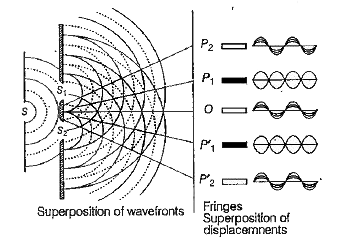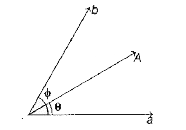Discuss Young.s double slit experiment. Derive its analytical expression for constructive and destructive interference.
Young.s Double Slit Experiment In 1800-1801, Thomass Young was the first person to demonstrate experimently the interference of light. Here, a source of monochromatic light illuminates a rectangular narrow slit S, about 1mm wide, as shown in figure.

S1andS2 are two parallel narrow slits which are arranged symmetrically and parallel to the slit S at a distance of about 10cm from it. The separation between S1andS2 is ≈2mm and width of each slit is ≈3mm. An observation screen is placed at a distance of ≈2m from the two slits. Alternate bright and dark bands appear on the observation scrren. These are called interference fringes.
Theory of Interference of Waves
Let the waves from two coherent sources of light be represented as y1=asinωtandy2=bsin(ωt+ϕ)
where, a and b are the respective amplitudes of the two waves and ϕ is the constant phase angle by which second wave leads the first wave. Applying superposition principle, the magnitude of the resultant displacement of the waves is
y=y1+y2 or y=asinωt+bsin(ωt+ϕ)[∵sin(A+B)=sinAcosB+cosAsinB]
or y=(a+bcosϕ)sinωt+bsinϕcosωt
Putting a+bcosϕ=Acosθandbsinϕ=Asinθ
we get, y=Acosθ.sinωt+Asinθ.cosωt
or y=Asin(ωt+θ)

where, A is the resultant amplitude and θ is the resultant phase difference.
∴A=√a2+b2+2abcosϕandtanθ=bsinϕa+bcosϕ
As, intensity is directly proportional to the aquare of the amplitude of the wave, i.e., I∝a2
So, for two different cases, I1=ka2,I2=kb2
∴IR=kA2=k(a2+b2+2abcosϕ)
∴IR=I1+I2+2√I1I2cosϕ
For Constructive Interference I should be maximum for which cosϕ= maximum =+1
∴ϕ=0,2π,4π.....
i.e. Phase difference ph=2nπ
where, n= 1, 2,...
If Δx be the path difference between the interfering waves, then
Δx=λ2πϕ=(λ2π)(2nπ)=nλ
Δx=nλandImax∝(a+b)2
Hence, condition for constructive interference at a point is that, the phase difference between the two waves reaching the point should be zero or an even integral multiple of 2π. Equivalent path difference between the two waves reaching the point should be zero or an integral multiple of full wavelength.
For Destructive Interference
I should be minimum, for which cosϕ= minimum = −1
∴ϕ=π,3π,5π
i.e., Phase difference, ϕ=(2n−1)π
where n -1, 2, 3...
The corresponding path difference between the two waves is
Δx=(λ2π)ϕ=(λ2π)(2n−1)π=(2n−1)λ2
∴Δx=(2n−1)=λ2andImin∝(a−b)2
Hence, condition for destructive interference at a point is that, the phase difference between the two waves reaching the point should be an odd integral multiple of π or path difference between the two waves reaching the point should be an odd integral multiple of half wavelength.
Similar Questions
(a) In Young's double slit experiment, derive the condition for (i) constructive interference and (ii) destructive interference at a point on the screen.
(b) A beam of light consisting of two wavelengths, 800 nm and 600 nm is used to obtain the interference frings in a Young's double slit experiment on a screen placed 1.4 m away. If the two slits are separated by 0.28 mm, calculate the least distance from the central bright maximum where the bright fringes of the two wavelengths coincide.View SolutionAnswer the following:
(a) In Young's double slit experiment, derive the condition for (i) constructive interference and (ii) destructive interference at a point on the screen.
(b) A beam of light consisting of two wavelengths, 800 nm and 600 nm is used to obtain the interference fringes in a Young's double slit experiment on a screen placed 1.4 m away. If the two slits are separated by 0.28 mm, calculate the least distance from the central bright maximum where the bright fringes of the two wavelengths coincide.View Solution
Knowledge Check
- Question 1 - Select One
In Young's double slit experiment, the interference bright fringes are of:
Aequal widths and unequal intensitiesBunequal width and equal intensitiesCequal widths and equal intensitiesDunequals widths and unequal intensities
In Young’s double slit experiment, deduce the condition for (a) constructive, and (b) destructive interference at a point on the screen. Draw a graph showing variation of intensity in the interference pattern against position ‘x’ on the screen.
View Solution(a) In Young's double-slit experiment, derive the condition for
(i) constructive interference and (ii) destructive interference ata point on the screen.
(b) A beam of light consisting of two wavelenths, 800 nm and 600 nm is used to obtain the interference fringes in a Young's double-slit experiment on a screen placed 1.4m away. if the two slits are separated by 0.28 mm, calculate the least distance from the central bright maximum where the bright fringes of the two wavelengths coincide.View Solution(i) In Young's double slit experiment the condition for (a) constructive and (b ) destructive interference at a point on the screen .
View SolutionState the importance of coherent sources in the phenomenon of interference.
In Young's double-slit experiment to produce interference pattern, obtain the conditions for constructive and destructive interference.
Hence, deduce the expression for the fringe width.
How does the fringe width get affected, if the entire experimental apparatus of Young's is immersed in water ?View SolutionState the importance of coherent sources in the phenomenon of interference. In Young's double slit expet-ment to produce interference pattern obtain the conditions for constructive and destructive interference. Hence deduce the expression for the fringe width. How does the firinge width get affected, if the entire experimental apparatus of Young's is immersed in water ?
View SolutionState the importance of coherent sources in the phenomenon of interference. In Young's double slit expet-ment to produce interference pattern obtain the conditions for constructive and destructive interference. Hence deduce the expression for the fringe width. How does the firinge width get affected, if the entire experimental apparatus of Young's is immersed in water ?
View SolutionYoung's Double Slit Experiment||Discussion -01
View Solution

